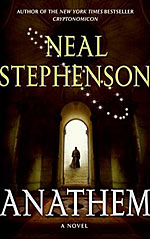
![]() Rhondak101
Rhondak101
6/7/2012
![]()
My paperback copy of Neal Stephenson’s Anathem is 950 pages. At page 400, I was sure I would never be able to write a review. By the time I reached page 800, I was composing sentences in my head as I performed daily activities, like brushing my teeth. However, writing a review for such a long and complex book is still a daunting task; therefore, I’m going to tell you a bit about the world of Anathem here (rather than the plot, which I realized as I was writing this is surprising simple) and hope that it inspires you to read the book and not be afraid of its size or its complexity. Stephenson’s basic premise is this: he takes the theories of well-known philosophers, such as Plato, Leibniz, Kant, Gödel, and Husserl (as cited in the acknowledgements) and translates them to a parallel universe on the planet Arbre where different philosophers have thought basically the same thoughts. For example, our Ockam’s Razor becomes their Gardan’s Steelyard (in which a steelyard is a balancing scale).
Philosophical discussions are the foundation of the community—the Concent of Saunt Edhar--we meet at the beginning of the book, a cloistered community of avouts who resemble medieval monks in many ways. However, their purpose is not religious worship but intellectual pursuits. In contrast to medieval monasteries, the community is open to both sexes and the avouts are not celibate. But like many of their medieval counterparts, they grow their own food and are self-sufficient. The name above Saunt Edhar indicates that their communities are named after “saints” of learning who helped their orders grow and prosper. The main taboo for their society is exposure to the outside world. Their “order” particularly limits their exposure to technology, especially computer technology. The avouts may use some technology in their studies, such as telescopes and laboratory equipment. However, they are limited in the ways that they use technology to communicate or as a pastime. Arbre’s internet is called the Reticulum. Those of the Saecular World (the world outside) have uncontrolled access to the Reticulum, while the rules of the avouts prohibit them from contact with the outside through this form. Instead, the technical infrastructure of the concents is managed by people called ITA, who are seen as “untouchables” by the avouts. The avouts are supposed to ignore the ITAs’ presence and have no personal contact with them.
The story is told as a first-person narrative by Erasmus, a fid (in medieval lingo, a novice), at Saunt Edhar. He is eighteen years old and has been a member for ten years. He and his contemporaries learn about philosophy, quantum mechanics, linguistics and many other topics through the Socratic method. In fact, the Socratic method is the way that the avout community approaches and solves problems, so the book is full of long and detailed dialogues. Many critics fault Stephenson for these long and nuanced discussions, calling them “info dumps” and saying that he can’t ever leave any point unexplained.
Stephenson gives his readers a lot of help immersing themselves in this world he has created. The book opens with a 7000-year timeline that explains the upheavals, wars, and revolutions of Arbre and the various schools of thought that arose in among the various concents throughout Arbre. In addition, there’s a twenty-page glossary at the end of the book. He also provides more detailed “dictionary” definitions throughout the book at the part and chapter divisions.
These nuanced discussions and scholarly apparatus are what I love about Stephenson. He is a fearless writer and thinker. He is not afraid to educate his readers, but he is not pedantic in doing so. This is a book of big ideas and is not ashamed of it. However, this is not the sum total of the book. It is also a coming of age story, a quest story, a first contact story, and a bit of a love story. My favorite part is the quest story because it is so familiar, yet Stephensonian at the same time. Stephenson spends a significant amount of time on each these stories as it folds into the next to create a fairly simple plot line. The philosophical dialogues and intricate descriptions are what give this novel the complexity that I love. Some books entertain, some raise questions, and others educate. Anathem does all three.
If you want to see more about the ideas Stephenson used to create his thinkers and philosophers, see his website